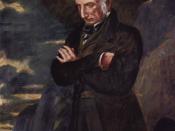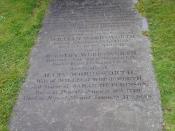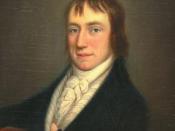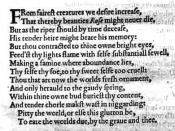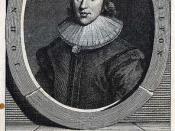John Milton's "How soon hath time"ÃÂ and William Wordsworth "Mutability"ÃÂ are two sonnet structured poems that both deal with the popular subject of time. The central theme of both poems is that, time is an inescapable force affecting everything in our world. The authors however have a different perspective on how they approach this theme, and through an analysis of the two sonnets tone and structure, it will become clear what each were aiming for. After that, a comparison of the two sonnets will be a simple task where their similarities and differences are discussed.
The tone Milton takes in his sonnet reflects his feelings on the subject. Personifying time and addressing it as "the subtle thief of youth"ÃÂ sets the attitude for the octave, in which Milton reflects on his life. Milton chooses to focus on the ways in which he has escaped time's effects. In the lines, "my semblance might deceive that truth That I to manhood am arriv'd so near"ÃÂ he states that he is more mature then his youthful looks may suggest.
His "inward ripeness"ÃÂ cannot be seen. His tone in the octave is of a defiant nature, like he has to prove to himself that he alone escapes time's hold. In the sestet Milton flips in his tone; it becomes more accepting as seen in the line "Yet it be less or more, or soon or slow"ÃÂ. He seems to understand that his maturity is of no consequence, because in the end "(it is) the strictest measure ev'n To that same lot"ÃÂ. He ends the poem, looking at the force of time as being another act of God, his "great Task-Master"ÃÂ, and in that case how could it be a malicious force.
Milton chooses a structure that is very formal for his poem. There are major punctuation breaks at the end of each quatrain and only one full stop in the sestet, which comes at the very end. The rhyme scheme is strictly Petrarchan, with no breaks from that structure. The metre of the sonnet is generally iambic, however there are trochees placed in almost every single line of the sonnet. These trochee breaks give the poem a lighter feel, which reflects Milton's attitude of passive acceptance to the workings of time.
Wordsworth takes a very melancholic attitude in his sonnet. He starts with "From low to high doth dissolution climb And sink from high to low"ÃÂ. He chooses to use the word "dissolution"àwhich is a very vivid and colourful term for death. It is eerie and links very nicely with the simile "melt like frosty rime"àthat appears in line eight. The line "Along a scale"æwhose concord shall not fail"ÃÂ, creates feelings of helplessness in the struggle against time. The second half of the sestet deals with time's unbiased nature, even those "who meddle not with crime, Nor avarice"àare not spared from time's wrath. In the poem's octave Wordsworth takes to using symbols, such as snow, as in the line "melt like frosty rime"àand a tower to cement the idea that time affects all things. Personifying the tower to a king, "tower sublime"æ(with) His crown of weeds"àsuggests that no matter how important (the king) or how strong (the tower) one cannot "sustain"æ the unimaginable touch of time"ÃÂ.
In the sonnet "Mutability"ÃÂ, the most striking thing about it after a first reading is its irregular structure. In analysis of its punctuation, the first major break comes at the end of the sixth line and the only other major break is the period at the end of the sonnet. This suggests that the sestet is before the octave of the poem. This is contradictory to traditional form. The sonnet's rhyme scheme, after the first four lines (they are in the regular "abba"ÃÂ form), becomes quite erratic. The metre of the sonnet is iambic pentameter with very few exceptions, which is extremely effective, especially in the sestet where the beating time of the iambic metre reflects Wordsworth's comparison to musical scales. When hearing the poem read out loud its marching rhythm is reinforced, bringing together Wordsworth's concept of the harsh and inevitable structure of time. The most interesting thing concerning the poem's structure, is the contrast between its type and its metre. Wordsworth appears to be lashing out at time, and its restrictions, by writing a sonnet that is outside the traditional rules of the form. And at the same time he admits to time's great power by writing a sonnet that reads like a drum beat in perfect time, making concrete his belief that time is some sort of fantastic slave driver.
The most striking similarity in the two sonnets is their subject, time. The metre for both sonnets is iambic pentameter. However, where Wordsworth has almost no variations from iambic metre, Milton makes liberal use of trochees to make his poem effective. Another difference is Milton's sonnet is petrarchan and Wordsworth's is irregular. Each works well in the author's structure of choice, and the type compliments each poem well. I feel Wordsworth's sonnet could have worked just as well if it was petrarchan, but it definitely wouldn't have had the flair that it possesses. As stated earlier they both are making the same statement "that time is an inescapable force affecting everything in our world"ÃÂ. Differences enter in when examining their feelings towards that statement. Milton looks at time as just another process of life and even a positive one considering that it is just another function of God's grand scheme. Wordsworth conversely feels that time is the soundtrack to the events that play until our eventual demise. Milton looks at time as an enlightener leading us to our maker, whereas Wordsworth sees time as a destructor. Even though the authors give such contrasting statements towards each others', they present their separate cases with such a mastery of their craft and of the sonnet form that I able to see the validity of both points of view at the same time.
